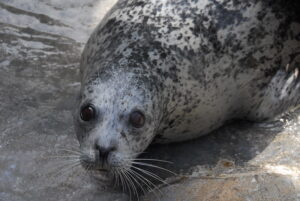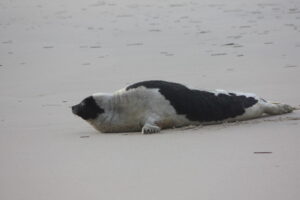As the holiday season winds down and social distancing rules remain intact, you may find yourself having extra free time. So what can you do that will create a memorable experience without risking your families health? As suggested in our recent Winter Recreation Guide, participate in an outdoor seal walk. You can find groups that offer guided tours or venture out to the water on your own in hopes of stumbling across some resting seals.
Long Island hosts five native seal species including; Harbor, Grey, Harp, Hooded, and Ringed seals. However, you’ll most likely come across either Harbor, Grey or Harp seals as Ringed and Hooded seals tend to stay toward arctic seas. For the most part, these seals will look pretty similar with their long torpedo-like bodies, flippers and caterpillar-like movement, but if you get a close look ( through binoculars, of course) you can discover distinctive traits between species. You’ll know you have spotted a Harbor seal if you see a dog-like snout with V-shaped nostrils and spots on the fur. In compassion, Grey seals have round heads with parallel nostrils and they’re typically grey or brown in color. Lastly, while very rare, you’ll know you’ve come across a Harp seal if you see black pigmentation on the snout and a black mark on their back that resembles a harp.
Now that you know the traits to identify the seals, it’s time to pick a location to start your seal-watching hunt. Seals have been spotted at the following park in the past,, so they may be worth a visit: Jones Beach State Park, Montauk Point State Park, or Cupsogue Beach State Park. You can also opt to attend a seal cruise or guided tours you can find online. We suggest checking out the Coastal Research and Education Society of Long Island. And, right now is the best time of year to see seals. From November to about April seals rest on sandy beaches to regulate body temperature or prepare for birth. If you’re lucky enough to spot some seals on your walk, keep your distance and do not disturb them. Seals are a federally-protected species and are protected against harassment and being killed. Harassment is defined as anything that can cause a change in the mammal’s behavior. Always maintain a 200 feet distance when observing seals. As adorable as they look, they are still unpredictable wild animals!
By Miranda Gonzales, Long Island Pine Barrens Society





